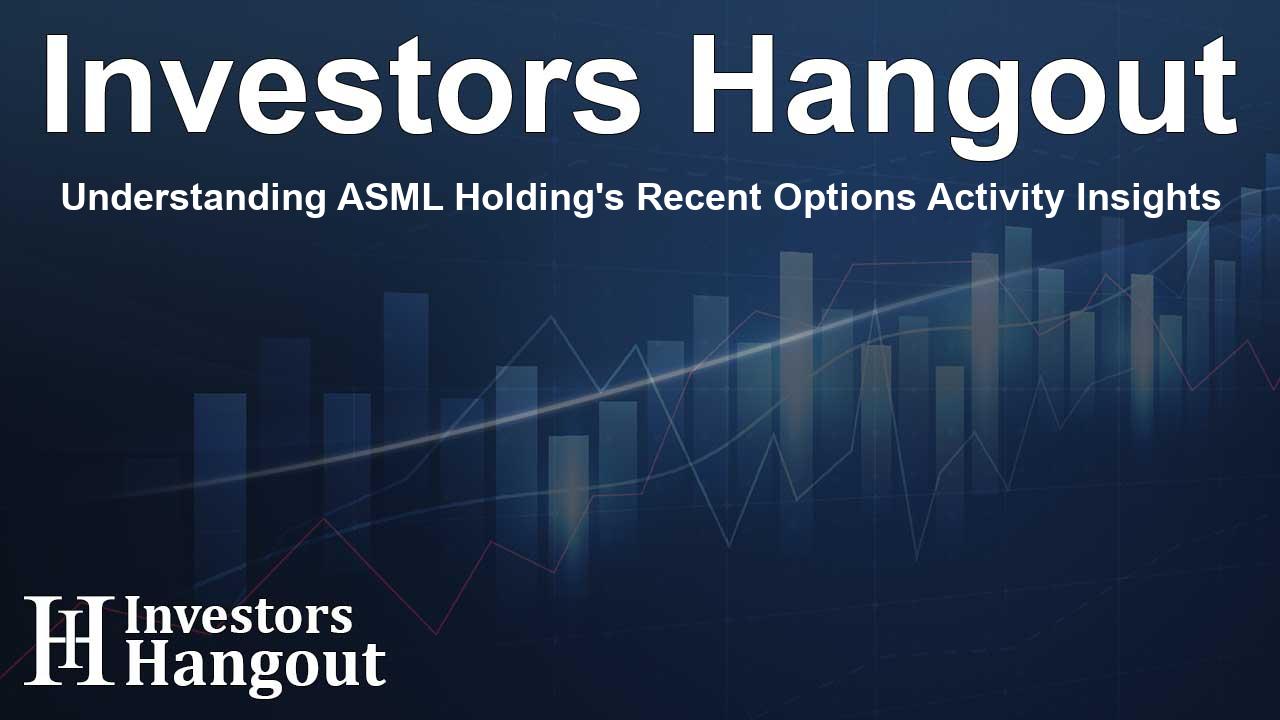Understanding ASML Holding's Recent Options Activity Insights

ASML Holding: Reading the Signals in Recent Options Activity
When big-money traders shift their posture, it can foreshadow what comes next for a stock. Lately, the options tape around ASML Holding (NASDAQ: ASML)—a cornerstone of the semiconductor supply chain—has tilted notably bearish.
If you trade your own account, staying close to these flows helps. The options history we’ve reviewed stands out for its size and tone, with several trades showing unusual volume and a clear stance from larger players.
What’s behind it? A blend of speculative moves by institutions and high-net-worth traders appears to be shaping ASML’s options market. When this crowd leans one way, it often reflects expectations for a move—or at least rising uncertainty worth hedging.
Here’s the short version of what the latest scan turned up: several atypical transactions in ASML options that are big enough to matter. Not just routine positioning, but trades that warrant a closer look.
What the Trading Says
Sentiment in these options flows is skewed bearish. Of the tracked activity, 61% was bearish, while 28% leaned bullish. The rest fell into neutral hedges or spreads. That imbalance is the headline.
Drilling into the dollars: 17 put trades totaled $1,163,983, while 4 call trades came to $244,918. Puts are typically used to profit from—or protect against—downside. The tilt toward puts suggests an emphasis on downside protection or speculation.
Where Traders Are Aiming
Strike selection tells you where traders expect the action. Based on volume and open interest, attention clustered in a band from $620.0 to $1000.0 over the last quarter. That range frames the market’s working assumptions for future swings.
Volume and Open Interest, Explained
Volume shows how many contracts changed hands today. Open interest shows how many contracts are still open, waiting to be closed or exercised. Together, they help you spot fresh positioning versus old bets being unwound. In ASML’s case, recent fluctuations in both call and put activity point to growing engagement from larger players within that strike range—energy gathering around key levels.
Notable Options Prints
Here are several flagged trades that stand out for size and tone. They don’t predict the future on their own, but they do sketch a map of where pressure could build:
- Symbol: ASML, Trade Type: PUT, Sentiment: BEARISH, Exp. Date: 10/18/24.
- Symbol: ASML, Trade Type: PUT, Sentiment: NEUTRAL, Exp. Date: 12/20/24.
- Symbol: ASML, Trade Type: CALL, Sentiment: BEARISH, Exp. Date: 09/19/25.
- Symbol: ASML, Trade Type: PUT, Sentiment: BEARISH, Exp. Date: 01/16/26.
- Symbol: ASML, Trade Type: PUT, Sentiment: BEARISH, Exp. Date: 10/18/24.
ASML, in Brief
ASML Holding builds photolithography systems—the machines that use light to etch circuit patterns onto silicon wafers. This step is central to chipmaking and to the steady rise in transistor density that’s powered modern computing. The company’s tools enable chip manufacturers to push performance forward and pack more transistors into each wafer. Major customers include TSMC, Samsung, and Intel.
ASML’s Current Market Setup
- ASML’s current trading volume stands at 375,043 units, with its stock price reflecting a slight drop of -1.31%, currently at $740.0.
- The Relative Strength Index (RSI) indicates the stock may be in an oversold condition, warranting further attention.
- Investors should prepare for the upcoming earnings report scheduled for the near future, which may provide additional market insights.
Options can magnify both risk and reward. If you’re trading them, anchor to a plan: define your time frame, size your positions, and know what would make you change your mind. Use volume and open interest to separate fresh conviction from noise. And remember—one strong day of flow doesn’t make a trend. A series does.
In the end, the note here is straightforward: large traders are leaning cautious on ASML right now. That doesn’t settle the debate, but it sets the tone.
Frequently Asked Questions
What’s behind the recent bearish tilt in ASML options?
Tracked options flows show a heavier share of bearish positioning—61% of the activity—versus 28% bullish. The size and direction of these trades point to increased hedging or speculation on downside.
How does ASML’s role in chipmaking shape investor sentiment?
ASML makes photolithography systems used to transfer circuit patterns onto wafers. Because those tools sit at the heart of semiconductor production, shifts in demand or industry cycles can quickly influence how traders price its stock and options.
What do the put and call totals tell me?
We observed 17 put transactions totaling $1,163,983 and 4 call trades totaling $244,918. The imbalance suggests more attention on downside protection or bearish bets than on upside exposure.
How should I read volume and open interest here?
Think of volume as today’s activity and open interest as the pile of outstanding contracts. Rising figures around the $620.0 to $1000.0 strikes indicate where traders are concentrating risk, which can become magnets for price action.
When is the next earnings report for ASML Holding?
The upcoming earnings report is scheduled in approximately 36 days, a timing that could influence options pricing and the stock’s next move.
About The Author
Contact Owen Jenkins privately here. Or send an email with ATTN: Owen Jenkins as the subject to contact@investorshangout.com.
About Investors Hangout
Investors Hangout is a leading online stock forum for financial discussion and learning, offering a wide range of free tools and resources. It draws in traders of all levels, who exchange market knowledge, investigate trading tactics, and keep an eye on industry developments in real time. Featuring financial articles, stock message boards, quotes, charts, company profiles, and live news updates. Through cooperative learning and a wealth of informational resources, it helps users from novices creating their first portfolios to experts honing their techniques. Join Investors Hangout today: https://investorshangout.com/
The content of this article is based on factual, publicly available information and does not represent legal, financial, or investment advice. Investors Hangout does not offer financial advice, and the author is not a licensed financial advisor. Consult a qualified advisor before making any financial or investment decisions based on this article. This article should not be considered advice to purchase, sell, or hold any securities or other investments. If any of the material provided here is inaccurate, please contact us for corrections.
